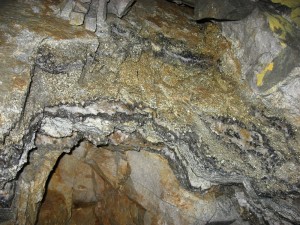Via CEO.ca and written by Mike Luft

On the back of a positive Preliminary Economic Assessment (“PEA”), one that demonstrated robust economics even at today’s gold prices, Toronto’s Continental Gold(TSX: CNL; OTCQX:CGOOF) is readying itself for another milestone at its flagship Buriticá mine – the completion of permitting by the end of Q2 2015.
If you’re unfamiliar with Continental Gold’s Buriticá mine, there are reasons you should know it. Buriticá has two qualities that are becoming scarcer in today’s world – size and grade. The underground Buriticá project boasts both of these qualities, and more.
Located in northwestern Colombia, approximately two hours away from the country’s second largest city, Medellín, Buriticá is a 100%-owned project with a paved road traversing the property and abundant electricity and water available nearby.
The mine is composed of two major vein systems named Veta Sur and Yaraguá, both of which have recently yielded excellent drilling results. In 2015, Continental Gold has announced results for numerous infill and extension drill holes, most of which intersected multiple vein families at substantially greater grades than what the existing mineral resource model predicted.
With an updated mineral resource estimate expected for release at the end of Q2 this year, Continental Gold has an internal target of seeing the mineral resources grow by up to another 1 million ounces overall, with a measured and indicated (M&I) resource goal of 3+ million ounces.
All this positions Continental Gold very well as it looks forward to its next development milestone – the final environmental permit for Buriticá. It already has its exploitation license at Buriticá, which it received in March of 2013, and which provides the company a 30-year license to mine.
Later that year, in December 2013, Continental Gold formally applied for its final environmental permit for the Buriticá mine with Corantioquia, the government agency in Antioquia, Colombia responsible for environmental permitting.
Following the submission of the application, Continental Gold communicated in their guidance that they would expect to receive the permit by the end of Q2 2015, which would then allow the company to begin construction at the mine.
Continental Gold remains fully confident in this timetable, and if you examine the current business environment in Colombia and how Buriticá fits in with Colombia’s ambitions as a country, one can see that Continental’s confidence is fairly well-founded.
Recently, we reached out to Ari Sussman, Continental Gold’s President and CEO. Sussman highlights two key points with regards to the mine: how serious Colombia is as a country in attracting foreign investment and, at the same time, how interested Colombia is in spurring additional business interest (there was a recent article in the The Northern Miner elaborating on just how organized Colombia has become in supporting “Projects of National Interest”).
“Colombia is today, and has been for many years now, a country with pro-business and right-wing elected governments,” Sussman comments. “The country enjoyed enormous growth in the early 2000s and that growth has only continued. Additionally, Colombia’s security has improved nation-wide leading to a tourism boom; in all major cities, foreign hotel chains like Sheraton, Hilton and Holiday Inn are suddenly appearing. The country really is transforming itself.”
Ari Sussman adds, “What makes the country particularly convenient for miners is that Colombia, which has always been friendly to direct foreign investment into its economy, has become much more secure in the rural areas since the turn of this century. Being the richest producer of gold in Latin American history, the future for precious metal projects looks bright within a mining industry presently dominated by coal production.”
Sussman also describes how the Buriticá mine fits in with Colombia’s national interests. In 2013, Colombia began a strategic infrastructure initiative called Projects of National and Strategic Interest, or PINES, as a way to strengthen the nation’s infrastructure and meet increasing energy demands. Projects included in the PINES initiative had to be of a certain scale in size and benefit the surrounding communities in Colombia.
In 2014, Continental Gold was included in the PINES initiative, giving the company one more bullet of confidence that it will receive full environmental permitting by the end of the second quarter this year.
Following the completion of permitting and an updated mineral resource estimate by the middle of this year, Continental Gold might initiate a feasibility study on Buriticá, with the goal of completing the study by the middle of 2016. If completed, and assuming the study yields positive economics, financing and construction would take place ahead of planned production in 2018.
When asked if Continental Gold would entertain being acquired by a larger gold mining company, Sussman said that all options would be put on the table in the interest of creating shareholder value.
“It is our preference to ultimately build and operate Buriticá,” Ari Sussman says. “However, we recognize that great gold mining companies can be born through strategic mergers, particularly during the bottoming process of a cyclical industry. The 2002 through 2005 period yielded some great companies through M&A activities, and that is not lost on us as we believe we are now entering a similar phase. However, we did not survive this four-year bear market (and counting) as a stand-alone company only to be acquired for cash at a multi-year low valuation. It would be far more attractive to us to review interesting merger concepts as a path forward to the future.
“Even though Colombia has a long-standing established mining industry, it is still a virgin frontier for discoveries, primarily due to the 25-year security-related exploration lapse that took place during the end of the 20th century. However, I believe we will see a strong mining renaissance over the next 25 years led by grass roots exploration discoveries. It takes perseverance to work in Colombia as a miner as it is still early days in the maturation process for the mining industry, but for those who endure and adhere to proper standards for environmental and social management, the rewards will be plentiful,” adds Sussman. “Continental Gold is at the forefront of this renaissance, in part because we have been in Colombia for so many years and have been able to position ourselves at just the right time.”
